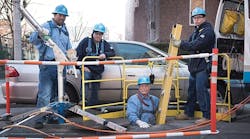When snow or sleet hit New York, hundreds of trucks roll to drop salt on the slickened streets. The salt helps drivers avoid fender benders; however, it also damages components of the underground electrical system when it washes into manholes and service boxes. The salt-water mixture coats the underground wiring and equipment, leading to customer outages, smoke and — on rare occasions — fires and explosions.
To keep New York City safe for the millions of pedestrians and drivers who traverse the busy streets every day, Con Edison is installing vented manhole and service box covers and investing in an aggressive program to replace underground cable.
Preventing Manhole Events
Now in the 11th year of its replacement program, Con Edison is swapping out traditional solid covers with vented covers. That way, if the underground wiring begins to smoke or catch fire, the vented cover design allows gases to escape, reducing the risk of explosions. The smoke billowing through a vented cover also can serve as an early warning system to the utility that underground wiring has been compromised.
The program has replaced more than 120,000 covers and plans to make another 55,000 replacements over the next four years. Overall, Con Edison maintains 246,000 manholes and service boxes in an expansive and complex underground electrical delivery system serving 2.5 million customers in New York City and Westchester County, New York.
Con Edison originally considered replacing all of its old manhole covers with vented covers. Instead, the utility worked with Columbia University researchers who developed an algorithm to target certain structures in Con Edison’s service territory. For example, under its former strategy, Con Edison might have replaced or vented three covers in the same intersection. The research with Columbia, however, showed it was only necessary to vent the middle structure because interconnected ducts vent the other two structures. By using the algorithm, the utility optimized its replacement program by targeting certain manholes, thus helping to control the costs and still reducing the risk of a manhole event.
Swapping Covers
Con Edison has collected and analyzed endless data on the performance of its electrical distribution system. To protect public safety, the utility began working on the development of new vented cover designs in the late 1990s. Over the years, the vented cover designs have evolved, and the company has worked with two different suppliers — East Jordan and Ross Technology. These manufacturers have produced the manhole covers in different shapes and sizes for Con Edison. While designing the covers, the vendors follow certain specifications. To ensure that the manufacturers are meeting the specifications, Con Edison provides them with standard drawings that they use during the production process.
For example, the covers must be within a certain weight range so they will not rattle when cars run over them. In addition, they must be vented at 22% for the optimal release of the combustible gases.
Currently, Con Edison is exploring modern designs for its covers. The utility is working with three manufacturers and testing new kinds of vented covers that it may start installing this year. The company is considering different venting designs or a cover with channels that reduce water runoff into the structures.
The utility also has an R&D initiative to test a cover that will be restrained or attached to the underlying structure. While it may open up at an angle or lift up vertically, it won’t soar into the air and possibly cause damage to nearby property or bystanders. Con Edison is waiting for test results from EPRI before installing these types of covers on the underground system.
Replacing Underground Cabling
In addition to replacing solid covers with vented covers, Con Edison has an aggressive program underway to replace underground cable. In 2015, workers added 833 miles of new wiring alone. Unlike traditional underground cable, the replacement cable is dual-layered and insulated with a low-smoke, fire-retardant jacket. If this cable does catch on fire, it won’t release any poisonous gases into the atmosphere.
Rather than replacing all of its underground cable, Con Edison is first targeting the sections with a history of failure due to years of exposure to salt, vibrations from traffic, biting by rats and other wear and tear. Through its proactive cable replacement program, the company uses the new cable during an emergency or a burnout. When considering whether or not to replace the cabling, the crews consider the age of the cabling as well as other factors.
Optimizing Replacement
In Manhattan, New York, the entire power infrastructure is underground, while the outer boroughs — the Bronx, Staten Island, Brooklyn and Queens — have a mix of underground and overhead cable.
To minimize inconvenience to residents, businesses and drivers, Con Edison coordinates its work with the city. For example, if the city is in a neighborhood digging in a street, the utility may replace cable in the area, possibly avoiding opening up the street again.
By replacing vault covers and aging underground cable, Con Edison maintains its reliability and protects the millions of people who are in the city every day.
Adrianne Ortizo is a manager in the distribution engineering department for Con Edison in New York, New York. She has been with the company for 14 years and is responsible for helping to manage the company’s public safety mitigation program, which includes vented manhole covers, contact voltage testing and capital projects to rebuild secondary systems.





